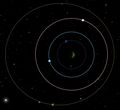Jool/pl
Jooljest Gazowym olbrzymem i szóstą planetą w systemie Kerbol. Jest najbardziej oddaloną planetą i bardzo trudną do osiągnięcia. Jest jednak jednym z najbardziej interesujących celów misji ze względu na swój skomplikowany układ pięciu księżyców:: Laythe, Vall, Tylo, Bop, oraz Pol. Orbity dobrze dostosowane do płaszczyzny orbity, i wiele skrzyżowań z orbitami księżyców, mogą być łatwo przechwycone przez księżyce z niewielka zmianą prędkości ΔV.
Atmosfera
|
Mimo, że Jool ma promień 10 razy większy niż Kerbin, jego atmosfera zaczyna się 2 razy wyżej (138.2 km). Jest również bardzo gęsta, dobrze nadaje się do hamowania aerodynamicznego. O Orbitowanie zaraz ponad atmosferą daje okres orbitalny równy 94.7437 minutom, i prędkość 6,785 m/s. Zazwyczaj nie trzeba schodzić poniżej 60 km, aby rozpocząć hamowanie aerodynamiczne. Ogólnie, ciśnienie atmosferyczne w Joolu dla wysokości wyrażonej w metrach: Closer to the surface, the physics of the game start to break down. Due to its extremely thick atmosphere, terminal velocity is so low that lighter spacecraft will not even need parachutes or retrorockets. It is not impossible to land on its solid surface, though spacecraft are inevitably and invariably devoured by the Kraken. If a Kerbonaut is put on EVA he will not be destroyed, making one-way sacrificial landings possible. However, as seen near the end of this video, the Kerbonaut will start to glitch out and shake uncontrollably. This only happens if you're on time warp 4. The game will later glitch and cut to a black screen with the altimeter going through numbers rapidly. Unless you restart the game, Kerbin's atmosphere will be missing. |
Natural Satellites
 The ocean moon Laythe, about to transit Jool. Jool has five natural satellites:
Laythe, Vall, and Tylo are in a Laplace resonance, with orbital periods of 1:2:4 respectively. Despite the fact that the moons can easily eclipse both each other and Jool, they do not. Gallery
Trivia
Changes
|
||||||




